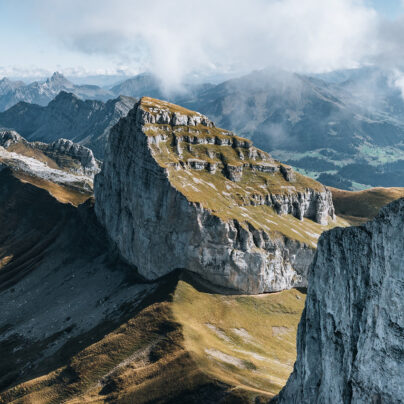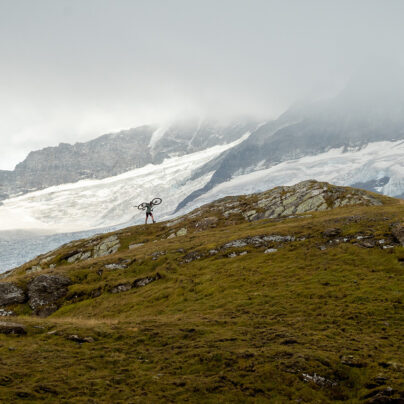No Trace
Seeking Purposeful Adventure
Words & Film by Markus Stitz // Photography by Finlay Anderson
Produced in Partnership with Trash Free Trails & Komoot
Slowly the light above the Lomond Hills faded away as I climbed the beautiful singletrack past John Knox’s Pulpit, a curious rock formation. A faint sandy path, cutting through the bracken, gave me a view towards a small stream meandering along the bottom of the valley. Only moments before I had been riding through a sea of purple and green. This dreamlike landscape was only an hour from the frenzy of Edinburgh – but already it felt like an entirely different world.
When I boarded the electric Ember bus at St Andrew Square the city wasn’t as busy as it usually gets every August, with thousands visiting for the festivals. I left the office earlier than usual for a quick escape. After weeks of working almost non-stop I felt that a break was long overdue. From similar adventures in the past, I knew how a night in the hills on my bike, reconnecting with nature, would help me to recharge my batteries and revive myself. The focus and clarity afterwards would outweigh any working time lost.
Although I know all those benefits well, excuses often get between plan and reality. I have many successful adventures to look back on. The longest was a trip around the world, but there have been many shorter jaunts too. Even the daily ride from my desk at Tribe, a shared office space and community hub in Portobello, to my home in Canonmills, is often adventurous. Adventures on two wheels help me to navigate through everyday life the best I can.
Thankfully there was no litter on the trails when I rode east out of Kinross, following the beautiful gravel tracks that line the shores of Loch Leven. There were smiles from fellow cyclists, a few short conversations in the passing, and the odd dog wagging its tail. Water reed, tall grass, and barley swayed in the blustery winds. Birds were circling above me while the sheep in the fields next to the track seemed to enjoy the rays of sunshine as much as I did – and as the weather seemed to be closing in, I resolved to enjoy it while it lasted. There were ample opportunities to observe the beautiful flora and fauna, but I saw no litter. Human civilisation has had a massive impact on Scotland’s largest lowland loch in the last 200 years. The canalisation of the River Leven reduced Loch Leven to 75 per cent of its former size. As the water level dropped, new islands appeared. The problem of litter seemed to have bypassed this tranquil place, at least so far – or someone had been quicker than me in collecting what others left behind.


But 75 per cent wasn’t just the figure that was connected with humanity’s impact on Loch Leven, it was also a percentage I had discovered a few days ago when planning the route for this adventure with komoot. Browsing other profiles for some inspiration, I stumbled across Trash Free Trails. On recent trips I started picking up odd bits of litter I found along the routes I rode. My ride this time wasn’t only a quick escape to recharge my batteries; it was also a small expedition to support the organisation. Set up to protect the trails we ride on and the wild places they take us, Trash Free Trails’ mission is to reduce single-use pollution, meaning litter, by 75 per cent by 2025, and reconnect people with nature through purposeful adventure.
After cruising along the shores of Loch Leven for a while, a small beach provided a perfect place to stop and linger. With my phone on airplane mode on most trips, bikepacking adventures allow me the rare opportunity to stop and reflect. I have often wondered why people would litter in the countryside – and not just since reading about Trash Free Trails. Is it simply an inconvenience to carry a few empty wrappers in your pockets home? Or is it the fact that plastic has become such an integral part of everyday life that its presence in the countryside no longer bothers people, even in the form of litter? And what are the alternatives to plastic, avoiding the problem we have created in the first place?
There were no simple answers to any of these questions. Standing on the beach, I enjoyed the different shades of grey and blue mixing on the surface of the water. I could spot some of the seven islands that lie within Loch Leven. While enjoying the tranquility, I tried to find answers. Even if plastic doesn’t bother some of us any longer, at best it inconveniences the other organisms that live around us. Or, at worst, it kills them. It will take about 500 years for a plastic bottle to break down. If Mary, Queen of Scots, who was imprisoned in 1567 on one of the islands I could see from the beach, had dropped a plastic bottle on those shores, it would have had an impact until a few decades before I was born. That plastic bottle would have witnessed many more events than any human being could experience in their lifetime.
I made a conscious effort when shopping for this trip. While it was impossible to find any pasta not wrapped in plastic, I managed to find cereal bars wrapped in plastic-free packaging and sold in fully recyclable cartons. My tea bags and packing were plastic free and would eventually compost; and, instead of carrying small sachets of instant coffee, I used a tin that could easily be refilled. The pesto came in a glass jar and was decanted into a reusable container before the trip, and my bread rolls were wrapped in paper, not a plastic bag. Maybe all of this was no more than a token gesture, but at least it made me think about how I could lessen my impact. And I took an electric bus to get to the start and finish and cycled the rest, so my emissions were close to zero.



Leaving the shores of Loch Leven, I continued on narrow country roads and gravel tracks. I stopped next to a beautiful meadow with all sorts of flowers. Only a few hours into the trip I could feel the stress of everyday life slowly vanishing. The clouds thickened and daylight began to fade as I climbed through Glen Vale. A remarkable rock outcrop, known as John Knox’s Pulpit, was a prominent landmark close to the highest point of the route. From here it would take me less than an hour to cross a stretch of open moorland to reach a resting place between West Lomond and East Lomond, situated on the road to Falkland, where I would camp for the night.
A few months ago, I worked on trails and a film in the Cateran Ecomuseum. When interviewing Jane Wilkinson, a local willow weaver and friend of mine, a few sentences she said back then stood out for me. When I edited the film Built to Last, I played Jane’s words over and over – they seemed to provide a good explanation for people’s actions in the countryside, good and bad.
‘I think it starts with the connection to the landscape. Because if you have a means or a vehicle that enables you to connect to the landscape, then you can develop that relationship, and that’s a relationship you start to honour and to cherish. And if you do that you’ll then be more mindful of your impact upon that relationship, and on the partner within that relationship, in terms of the wild spaces and the not-wild spaces around you. And then you go and become a very small thing in a big story, which is the historical and geographical story of the landscape. And you realise that you have the power to have an impact on that story.’
I arrived in darkness, and after a nice meal of basic pasta with pesto and a sip from my hip flask I fell asleep. When I woke up the next morning at 6.00am, heavy rain was pelting against my tent. I decided to cut my route a bit short, and in Falkland I utilised the empty tables outside The Covenanter (famous from Outlander) to boil some water for coffee and eat the remains of my bread roll, as the pub was still closed. Though in reality a very simple breakfast in dreich Scottish weather, it felt like a five-star meal. I was outside and happy. The owner popped outside, but instead of moving me on, he asked me about my trip, offered to fill my bottles, and wished me well.



On my way back to the bus station I picked up a few pieces of roadside litter, and less than 24 hours later I was back at my desk. While I still haven’t found the answers to my questions, I had a lovely time reconnecting with nature through a purposeful adventure. Even on such a short trip nature provided me with so much goodness, and I was thankful for that. I was a tiny part of a big story. But no matter how tiny, by acting respectfully, I still had an impact on that story. And that’s what made me smile.
Website: trashfreetrails.org // Instagram: @trashfreetrails
Website: komoot.com // @komoot
Written by Markus Stitz // @reizkultur
Photography by Finlay Anderson // @finlayanderson1






